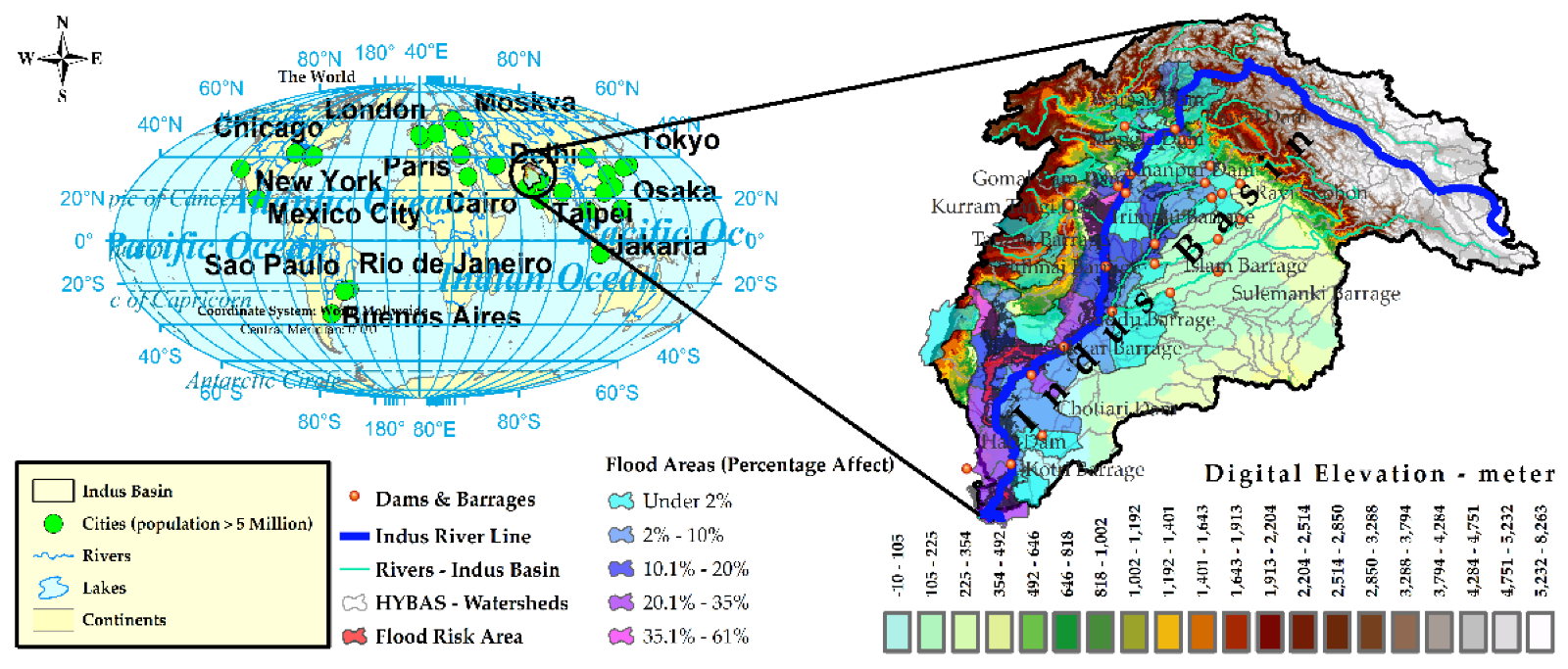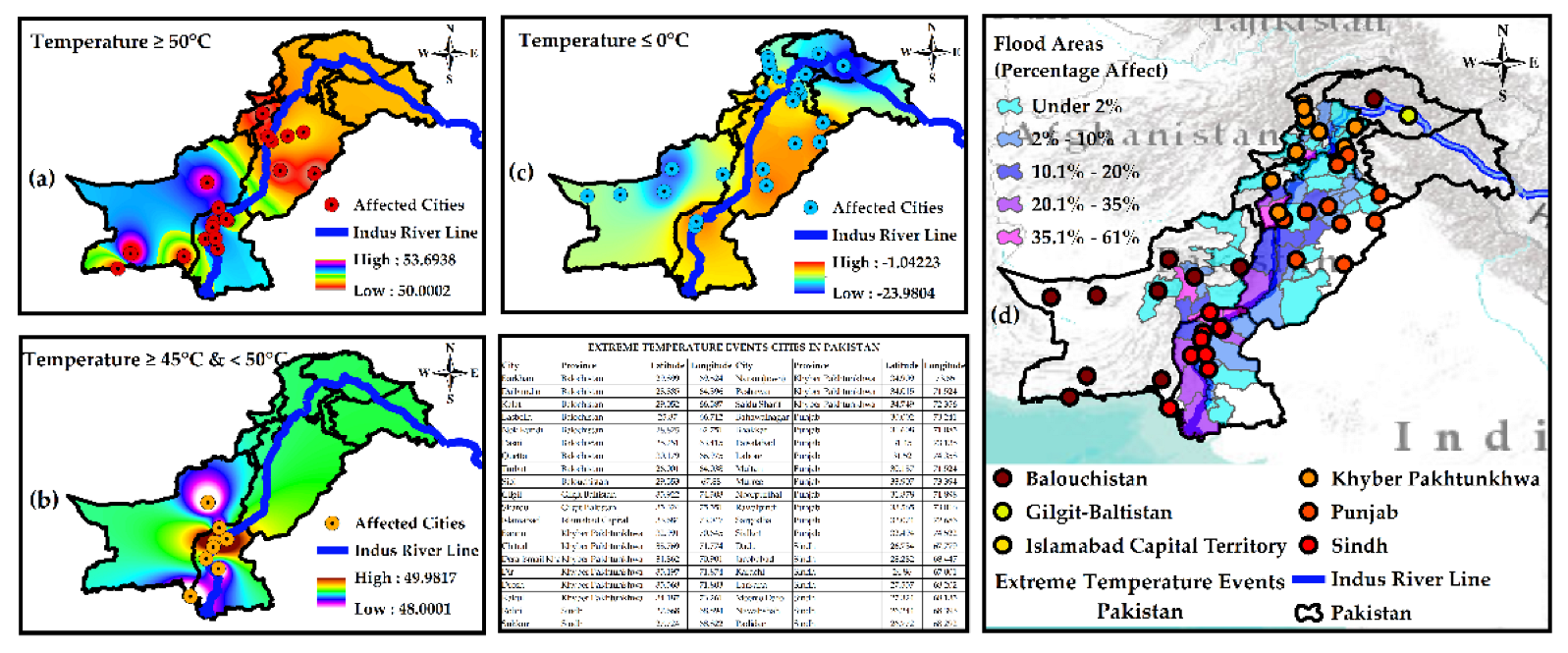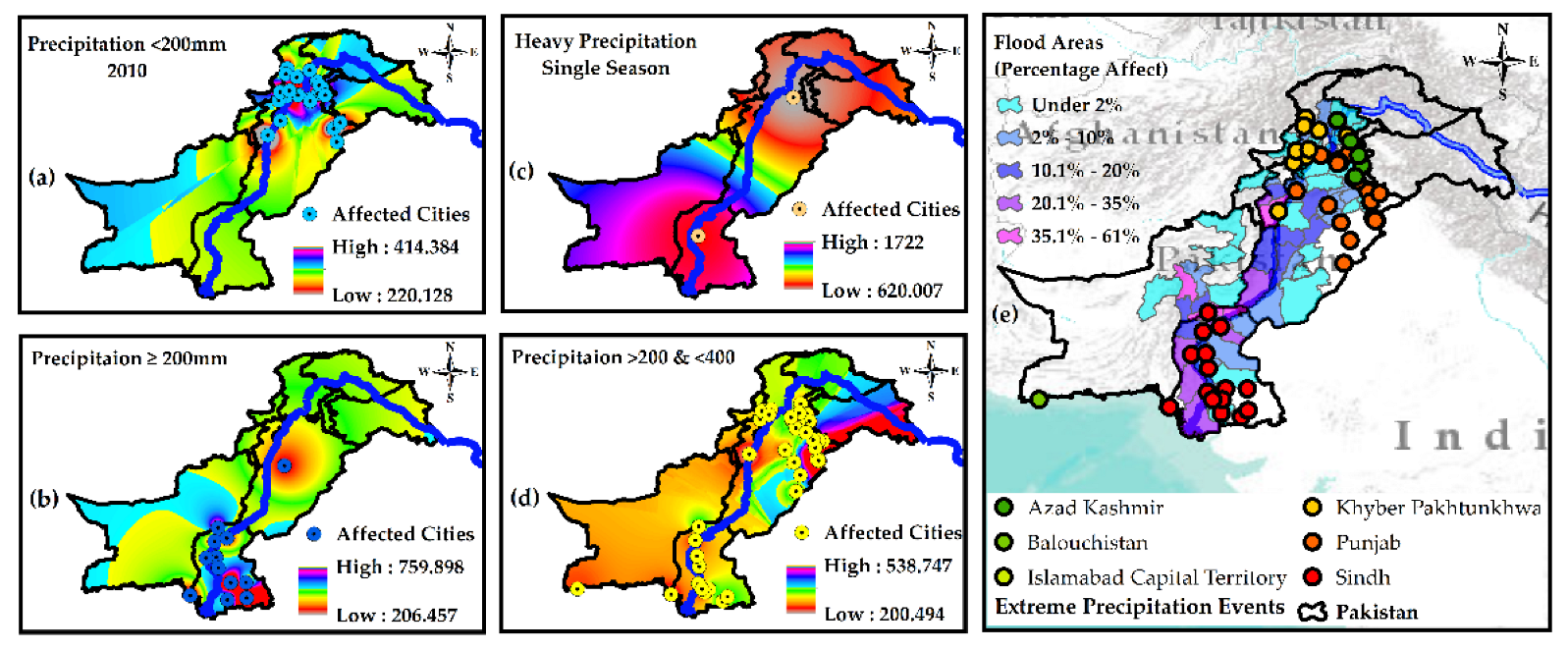Sustainable Water Management in Indus Basin and Vulnerability Due to Climate Change †
Abstract
:1. Introduction
2. Materials and Methods
2.1. Study Area
2.2. Data Collection and Analysis
3. Results and Discussion
3.1. Sustainability of Water
3.2. Extreme Events
3.2.1. Temperature
3.2.2. Precipitation
3.2.3. Vulnerability Due to Climate Change
4. Conclusions
Author Contributions
Funding
Institutional Review Board Statement
Informed Consent Statement
Data Availability Statement
Conflicts of Interest
References
- Bhatti, M.T.; Anwar, A.A.; Shah, M.A.A. Revisiting telemetry in Pakistan’s Indus basin irrigation system. Water 2019, 11, 2315. [Google Scholar] [CrossRef]
- Dhaubanjar, S.; Lutz, A.F.; Gernaat, D.E.; Nepal, S.; Smolenaars, W.; Pradhananga, S.; Biemans, H.; Ludwig, F.; Shrestha, A.B.; Immerzeel, W.W. A systematic framework for the assessment of sustainable hydropower potential in a river basin—The case of the upper Indus. Sci. Total Environ. 2021, 786, 147142. [Google Scholar] [CrossRef] [PubMed]
- Yaqoob, H.; Teoh, Y.H.; Sher, F.; Ashraf, M.U.; Amjad, S.; Jamil, M.A.; Jamil, M.M.; Mujtaba, M.A. Jatropha curcas biodiesel: A lucrative recipe for Pakistan’s energy sector. Processes 2021, 9, 1129. [Google Scholar] [CrossRef]
- Hussain, S.; Malik, S.; Masud Cheema, M.; Ashraf, M.U.; Waqas, M.; Iqbal, M.; Ali, S.; Anjum, L.; Aslam, M.; Afzal, H. An Overview on Emerging Water Scarcity Challange in Pakistan, Its Consumption, Causes, Impacts and Remedial Measures. Big Data Water Resour. Eng. 2020, 1, 22–31. [Google Scholar] [CrossRef]
- Janjua, S.; Hassan, I.; Muhammad, S.; Ahmed, S.; Ahmed, A. Water management in Pakistan’s Indus Basin: Challenges and opportunities. Water Policy 2021, 23, 1329–1343. [Google Scholar] [CrossRef]
- Lau, W.K.; Kim, K.M. The 2010 Pakistan flood and Russian heat wave: Teleconnection of hydrometeorological extremes. J. Hydrometeorol. 2012, 13, 392–403. [Google Scholar] [CrossRef]
- Qureshi, A.S.; McCornick, P.G.; Qadir, M.; Aslam, Z. Managing salinity and waterlogging in the Indus Basin of Pakistan. Agric. Water Manag. 2008, 95, 1–10. [Google Scholar] [CrossRef]
- Syed, A.; Sarwar, G.; Shah, S.H.; Muhammad, S. Soil Salinity Research in 21st Century in Pakistan: Its Impact on Availability of Plant Nutrients, Growth and Yield of Crops. Commun. Soil Sci. Plant Anal. 2021, 52, 183–200. [Google Scholar] [CrossRef]
- Watto, M.A.; Mugera, A.W. Groundwater depletion in the Indus Plains of Pakistan: Imperatives, repercussions and management issues. Int. J. River Basin Manag. 2016, 14, 447–458. [Google Scholar] [CrossRef]
- Arshad, S.; Shafqat, A. Food Security Indicators, Distribution and Techniques for Agriculture Sustainability in Pakistan. Int. J. Appl. Sci. Technol. 2012, 2, 137–147. [Google Scholar]
- WMO Verifies 3rd and 4th Hottest Temperature Recorded on Earth | World Meteorological Organization. 2022. Available online: https://public.wmo.int/en/media/press-release/wmo-verifies-3rd-and-4th-hottest-temperature-recorded-earth (accessed on 1 March 2023).
- Enhanced POWER Data Access Viewer (Beta). Available online: https://power.larc.nasa.gov/data-access-viewer/ (accessed on 1 March 2023).



Disclaimer/Publisher’s Note: The statements, opinions and data contained in all publications are solely those of the individual author(s) and contributor(s) and not of MDPI and/or the editor(s). MDPI and/or the editor(s) disclaim responsibility for any injury to people or property resulting from any ideas, methods, instructions or products referred to in the content. |
© 2023 by the authors. Licensee MDPI, Basel, Switzerland. This article is an open access article distributed under the terms and conditions of the Creative Commons Attribution (CC BY) license (https://creativecommons.org/licenses/by/4.0/).
Share and Cite
Zahra, S.M.; Shahid, M.A.; Misaal, M.A.; Zaman, M.; Imran, M.; Azam, S.; Hussain, F. Sustainable Water Management in Indus Basin and Vulnerability Due to Climate Change. Environ. Sci. Proc. 2023, 25, 36. https://doi.org/10.3390/ECWS-7-14203
Zahra SM, Shahid MA, Misaal MA, Zaman M, Imran M, Azam S, Hussain F. Sustainable Water Management in Indus Basin and Vulnerability Due to Climate Change. Environmental Sciences Proceedings. 2023; 25(1):36. https://doi.org/10.3390/ECWS-7-14203
Chicago/Turabian StyleZahra, Syeda Mishal, Muhammad Adnan Shahid, Muhammad Aali Misaal, Muhammad Zaman, Muhammad Imran, Sidra Azam, and Fazal Hussain. 2023. "Sustainable Water Management in Indus Basin and Vulnerability Due to Climate Change" Environmental Sciences Proceedings 25, no. 1: 36. https://doi.org/10.3390/ECWS-7-14203
APA StyleZahra, S. M., Shahid, M. A., Misaal, M. A., Zaman, M., Imran, M., Azam, S., & Hussain, F. (2023). Sustainable Water Management in Indus Basin and Vulnerability Due to Climate Change. Environmental Sciences Proceedings, 25(1), 36. https://doi.org/10.3390/ECWS-7-14203








